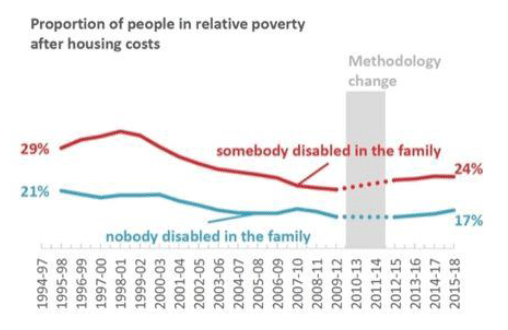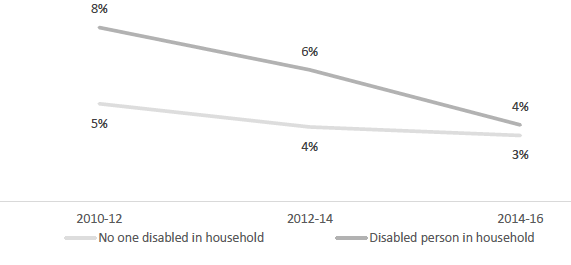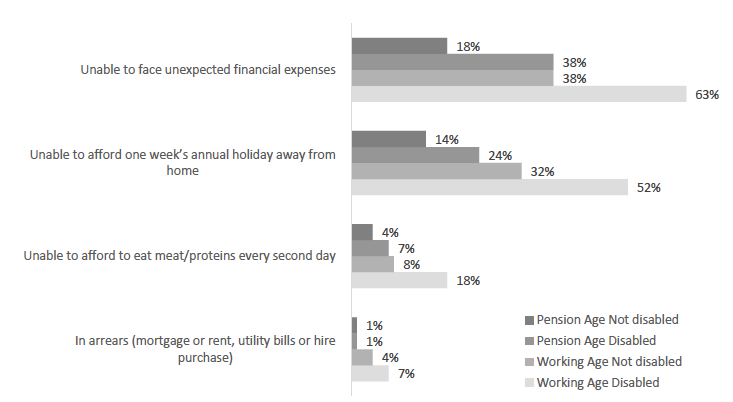Scotland's Wellbeing: national outcomes for disabled people
Analysis of the National Performance Framework (NPF) outcome indicators from the perspective of disability.
12. Poverty
We tackle poverty by sharing opportunities, wealth and power more equally
What we Know:
- Families with at least one disabled member were more likely than families without a disabled member to live in relative poverty after housing costs. If disability benefits are discounted – to allow for the higher living costs for disabled people - this disparity increases (30% compared to 16%).
- Levels of housing satisfaction are similar for disabled and non-disabled people.
- Levels of unmanageable debt are small but comparable between households with disabled members and those without (4% and 3% respectively).
- Disabled people were significantly more likely to experience food insecurity (18% compared to 5%).
- Rates of material deprivation are higher amongst disabled people.
- Costs of living for disabled people vary considerably making them difficult to measure robustly but are generally higher than for non-disabled people.
National outcome
This outcome aims to identify and address the root causes of poverty and disadvantage and set in place the actions to eradicate poverty for good. It is supported by a range of data that considers performance on poverty and income, housing, ethnicity, gender, health, disability and age.
National Performance Indicators
There are seven indicators for poverty in the national performance framework. Two, however, lack a demographic breakdown that includes disability:
- Cost of living (Median percentage of net income spent on housing, fuel and food).
- Persistent poverty (The proportion of people in Scotland living in relative poverty after housing costs for three out of the last four years).
The Living Cost and Food survey from which we derive the cost of living indicator does not currently include a disability question to allow this breakdown to be calculated. Persistent poverty by disability has not been reported but can be calculated from the data. We will report this in the equality evidence finder in the coming months. However, figures have been provided for persistent child poverty in Scotland, broken down by whether there is a disabled person in the benefit unit – i.e. a single person or couple and any dependent children. Figures have also been generated for the UK as a whole. Both are provided below in ‘Additional Indicators’.
The fourth indicator is a broad societal measure, rather than an individual measure, so is not useful for our purposes.
- Wealth Inequality (Wealth inequality as measured by the Gini coefficient which ranges from 0 (perfect equality) to 100 (maximal inequality).)
The remaining four indicators, however, are available broken down by disability:
- Satisfaction with Housing (The percentage of households who report being either "very satisfied" or "fairly satisfied" with their house or flat).
- Relative poverty after housing costs (The proportion of individuals living in private households with an equivalised income of less than 60% of the UK median after housing costs)
- Unmanageable debt (The proportion of households in unmanageable debt: either excessive debt repayments/arrears on commitments, or high debt levels relative to annual income).
- Food insecurity (The proportion of adults reporting that, at some point in the previous 12 months, they were worried they would run out of food because of a lack of money or other resources).
Satisfaction with Housing
According to the SHS, 89% of disabled people were either very or fairly satisfied with their household, compared to 93% of non-disabled people. However, the disparity in satisfaction is not statistically significant.
Relative Poverty after Housing Costs
Families with at least one disabled member are more likely to live in poverty after housing costs, compared to families without a disabled member (see Figure 12.1). In 2015-18, the Scottish Government[56] estimated that 24% of families with at least one disabled member were in relative poverty after housing costs, compared to 17% of families without a disabled member.[57]
The Scottish Government also produces estimates of the rate of poverty among households containing a disabled person which exclude the value of disability related benefits from household income. This adjustment seeks to address the higher living costs of disabled people. As these costs must be partly addressed by benefits, including them as a form of income may underestimate the extent of poverty among disabled households. After excluding disability related benefits from household income, the relative poverty rate after housing costs in 2015-18 was 30% among households with a disabled member, compared to 16% among those without a disabled member.[58]
Figure 12.1 The proportion of individuals living in private households with an equivalised income of less than 60% of the UK median after housing costs, 2012-17, by whether family has a disabled person.

Source: Poverty and income inequality in Scotland: 2015-18
Alternative, but comparable estimates can be found in research commissioned by the Joseph Rowntree Foundation (JRF) and published by the New Policy Institute (NPI) in 2016[59]. This research, concerned with the UK as a whole, found that:
- 31% of people in a family with a disabled person are in poverty after housing costs, with 18% of people in a family with no disabled people.
- 44% of disabled young adults (16-24) are in poverty, along with 66% of single disabled people living alone.
- 25% of working-age disabled people earn less than 50% of the median income, compared with 13% of non-disabled working people.
- 18% of working age disabled people are severely materially deprived, three times as high as the proportion of non-disabled working-age people.
Unmanageable Debt
The Wealth and Assets Survey[60] estimates that 4% of households with a disabled member have unmanageable debt, compared to 3% of households with no disabled members (see Figure 12.2).
Figure 12.2 The proportion of households in unmanageable debt, either excessive debt repayments or arrears on commitments, or high debt levels relative to annual income, 2010-16, by presence of a disabled person in the household.

Source: Wealth and Assets Survey 2018
The gap between households with a disabled member and without has narrowed considerably over the 6 year period for which data is available. By comparison, in 2010-12, 8% of households with a disabled member had unmanageable debt, compared to 5% of families that did not have a disabled member.
Food Insecurity
The SHeS reports that 18% of disabled people experienced food insecurity, compared to 5% of non-disabled people (see Figure 12.3). Analysis from the Trussell Trust indicates that, compared to low-income households within the general population, low income households with a disabled member are almost three times more likely to use food banks.[61]
Figure 12.3 The proportion of adults reporting that, at some point in the previous 12 months, they were worried they would run out of food because of a lack of money or other resource, in 2017, by disability.

Source: Scottish Health Survey 2017
Additional Indicators
Wealth and Assets
In 2014, a review of longitudinal and cross-sectional data for the London School of Economics (LSE) found large differences in assets between disabled and non-disabled people in the UK as a whole:
- In 2008/10 disabled people were living in households where total household wealth was £184,000 less, on average, than for non-disabled people, after controlling for age, marital status and dependent children.
- Disabled people retire with less private pension wealth. In the 55-64 age group the gap in the mean level of private pension wealth is £125,000 and the gap at the median is £75,000.[62]
Costs of Living
It is generally recognised that disabled people face higher costs of living than non-disabled people. These additional costs may include, for example, specialist equipment and home adaptations, specialist therapies (including, in some cases, therapies for parents), specialists toys and play equipment and increased energy costs, either as a result of increased heating for those with limited mobility or the cost of running specialist electrical equipment. However, given the high level of variation, producing a consistent estimate of these costs is challenging.
One attempt to estimate these costs on an average basis comes from the charity Scope[63] which observes that, for the UK as a whole:
- On average, disabled adults face extra costs of £583 a month. For one in five disabled adults, these costs can increase to over £1,000 a month even after the receipt of welfare benefits. On average, these extra costs are equal to almost half the income of a disabled person, after housing costs.
- Having one child with disabilities costs a family an extra £528 a month, rising to £823 a month in families with two or more disabled children. When both parents are in work, this is £533, compared to families where both parents are out of work when the cost is £649 a month. For almost one quarter of families with disabled children, extra costs amount to over £1,000 a month.
In addition, Scope research has found that disabled people may also face higher energy costs.[64] Their report indicates that around a third of disabled adults felt that their impairment or condition had an impact on how much they spent on energy. While the average UK household spends £1,214 on energy, over a quarter (4.1 million) of households with a disabled person spent more than £1,500 on energy. Of these, 790,000 spend over £2,500. In England, households with a disabled person make up 38% of all fuel poor households.
Material Deprivation
Evidence suggests that disabled people are more likely to live in material deprivation than non-disabled people. In 2016, the New Policy Institute (NPI) estimated material deprivation for working age and pension age disabled and non-disabled people, based on EU-SILC data from 2013 (see Figure 12.4)[65]. This analysis found higher rates of material deprivation among disabled people of working age and pensioners compared to their non-disabled counterparts. For example, it estimates that 7% of working age disabled people were in arrears for mortgage, rent, utility bills or hire-purchase, compared to 4% of non-disabled working age people.
Figure 12.4 Levels of Material Deprivation by Disability, 2013.

Source: EU-SILC, Eurostat. Sourced from New Policy Institute 2016
Persistent Poverty
In the UK as a whole, analysis from the DWP in 2019 found that, among working-age adults, disabled people had a higher likelihood of having a persistently low income (i.e. 60% of the median). Before housing costs, 12% of disabled people in 2013-17 had a persistently low-income, compared to 7% of those with a non-limiting long-term condition and 6% of those with no long-term conditions. After housing costs, 19% of disabled people were in persistently low income in the same period, compared to 11% of those with non-limiting long-term conditions and 10% of those with no long-term conditions. [66]
Persistent child poverty for children with a disabled adult within the ‘benefit unit’ - i.e. a single adult or couple and any dependent children - has been calculated for Scotland. In 2013-17, the rate of persistent child poverty in benefit units with a disabled members was 14%, compared to 17% among all children.[67]
Access to Accessible Housing
The EHRC, in 2018[68], reported that:
- 55% of Scottish councils said a lack of funding for adaptations was a challenge.
- Only 17% of Scottish councils set a target for accessible and/or adaptable housing.
- Only 24% of Scottish councils said the data they held about disabled people’s housing requirements was ‘good’ or ‘very good’.
- 61,000 people in Scotland need adaptations to their home.[69]
- Only 0.7 per cent of Scottish local authority housing, and 1.5 per cent of housing managed by Registered Social Landlords, is accessible for wheelchair users.[70]
- Almost 10,000 disabled Scots are on housing waiting lists.
- 41% of Scottish local authorities delivered an adaptation within eight weeks of a decision, although some disabled people waited for six months or more.
Contact
Email: joseph.ritchie@gov.scot
There is a problem
Thanks for your feedback